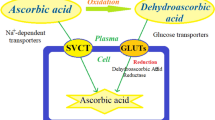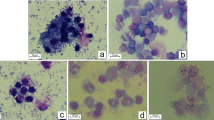Abstract
The inhibitory action of azelastine hydrochloride (Azeptin) on the respiratory burst in peripheral polymorphonuclear leukocytes (PMN) and pulmonary alveolar macrophages (PAM) has been studied. Azeptin in vitro suppressed chemiluminescence and superoxide (O -2 ) generation by human PMN in a dose-and time-dependent manner. Phorbol myristyl acetate (PMA) and formyl-methionyl-leucyl-phenylalanine (FMLP)-induced O -2 generation were strongly suppressed by 10−6M and 10−5M Azeptin, respectively. PMN and PAM from rabbits injected with Azeptin 0.2 mg·kg−1 for 5 days showed lower chemiluminescence and O -2 generation than cells from untreated rabbits. Nitroblue tetrazolium reduction activity in human PMN was suppressed by treatment of PMN with 10−6M Azeptin for 6 h. Inositol trisphosphate, intracellular free calcium, and protein kinase C activity were decreased by 10−6M to 10−5M Azeptin. The tyrosine phosphorylation of many proteins, especially a 115 kDa protein, was suppressed by 10−5M Azeptin. However, superoxide dismutase activity in PMN, PAM, and lung tissue samples was only slightly decreased, even when the rabbits were treated with 1.0 mg·kg−1 Azeptin for 5 days. The results suggest that Azeptin suppresses multiple signal transduction steps in the respiratory burst of PMN. This suppressive action should be very useful in the prevention and treatment of reactive oxygen-associated disorders.
Similar content being viewed by others
Abbreviations
- Azeptin:
-
azelastine hydrochloride
- PMN:
-
polymorphonuclear leukocytes
- PAM:
-
pulmonary alveolar macrophages
- PMA:
-
phorbol myristyl acetate
- FMLP:
-
formyl-methionyl-leucyl-phenylalanine
- PKC:
-
protein kinase C
- ROS:
-
reactive oxygen species
- O -2 :
-
superoxide
- IP3 :
-
inositol 1,4,5-trisphosphate
- DG:
-
diacylglycerol
- NBT:
-
nitroblue tetrazolium
- SOD:
-
superoxide dismutase
- TNF-α:
-
tumor necrosis factor-alpha
References
Spector SL, Perhach JL, Rohr AS, Rachelefsky GS, Katz RM, Siegel SC (1987) Pharmacodynamic evaluation of azelastine in subjects with asthma. J Allergy Clin Immunol 80: 75–80
Katayama S, Akimoto N, Shionoya H, Morimoto T, Katoh Y (1981) Anti-allergic effect of azelastine hydrochloride on immediate hypersensitivity reactions in vivo and in vitro. Arzneimittelforschung 31: 1196–1203
Chand W, Pillar J, Diamantis W, Sophia RD (1985) Inhibition of allergic histamine release by azelastine and selected antiallergic drugs from rabbit leukocytes. Int Arch Allergy Appl Immunol 77: 451–455
Little MM, Casale TB (1989) Azelastine inhibits IgE-mediated human basophil histamine release. J Allergy Clin Immunol 83: 862–865
Ueta E, Osaki T, Yoneda K, Yamamoto T, Kato I (1994) A clinical trial of Azelastine in recurrent aphthous ulceration, with an analysis of its actions on leukocytes. J Oral Pathol Med 23: 123–129
Bamberger DM, Herndon BL (1990) Bacteriocidal capacity of neutrophils in rabbits with experimental acute and chronic abscess. J Infect Dis 162: 186–192
Mimnaugh EG, Dusre L, Atwell J, Myers CE (1989) Differential oxygen radical susceptibility of adriamycin-sensitive and-resistant MCF-7 human breast tumor cells. Cancer Res 49: 8–15
Babior BM (1978) Oxygen-dependent microbial killing by phagocytes. N Engl J Med 298: 659–721
Ferrante A (1989) Tumor necrosis factor alpha potentiates neutrophil antimicrobial activity: increased fungicidal activity against Torulopsis glabrata and Candida albicans and associated increases in oxygen radical production and lysosomal enzyme release. Infect Immun 57: 2115–2122
van Oers NSC, Tao W, Watts JD, Johnson P, Aebersold R, Teh H-S (1993) Constitutive tyrosine phosphorylation of the T-cell receptor (TCR)ζ subunit: Regulation of TCR-associated protein tyrosine kinase activity by TCRζ. Mol Cell Biol 13: 5771–5780
Pleiman CM, Clark MR, Timson-Gauen LK, Winitz S, Coggeshall KM, Johnson GL, Shaw AS, Cambier JC (1993) Mapping of sites on the Src family protein tyrosine kinases p55blk, p59fyn, and p56lyn which interact with the effector molecules phospholipase C-γ 2, micro-tubule-associated protein kinase, GTPase-activating protein, and phosphatidylinositol 3-kinase. Mol Cell Biol 13: 5877–5887
Kanner SB, Grosmaire LS, Ledbetter JA, Damle NK (1993) β2-integrin LFA-1 signaling through phospholipase C-γ 1 activation. Proc Natl Acad Sci USA 90: 7099–7103
Berkow RL, Dodson R (1991) Alterations in tyrosine protein kinase activities upon activation of human neutrophils. J Leukocyte Biol 49: 599–604
McColl SR, Dipersio JF, Caon AC, Ho P, Naccache PH (1991) Involvement of tyrosine kinases in the activation of human peripheral blood neutrophils by granulocyte-macrophage colony-stimulating factor. Blood 78: 1842–1852
Akimaru K, Utsumi T, Sato EF, Klostergaard J, Inoue M, Utsumi K (1992) Role of tyrosyl phosphorylation in neutrophil priming by tumor necrosis factor-α and granulocyte colony stimulating factor. Arch Biochem Biophys 298: 703–709
Strum JC, Nixon AB, Daniel LW, Wykle RL (1993) Evaluation of phospholipase C and D activity in stimulated human neutrophils using a phosphono analog of choline phosphoglyceride. Biochim Biophys Acta 1169: 25–29
Böyum A (1968) Isolation of mononuclear cells and granulocytes from human blood. Scand J Clin Lab Invest 21: 77–98
Reynolds HY, Thompson RE (1973) Pulmonary host defenses, II. Interaction of respiratory antibodies with Pseudomonas aeruginosa and alveolar macrophages. J Immunol 111: 369–380
Palmer S, Hughes KT, Lee DY, Wakelam MJ (1989) Development of a novel, Ins (1,4,5) P3-specific binding assay. Its use of determine the intracellular concentration of Ins (1,4,5) P3 in unstimulated and vasopressin-stimulated rat hepatocytes. Cell Signal 1: 147–156
Hannun YA, Loomis CR, Bell RM (1985) Activation of protein kinase C by Triton X-100 mixed micelles containing diacylglycerol and phosphatidylserine. J Biol Chem 260: 10039–10043
Wray D, Charon J (1991) Polymorphonuclear neutrophil function in recurrent aphthous stomatitis. J Oral Pathol Med 20: 392–394
Õyanagi Y (1984) Reevaluation of assay methods and establishment of kit for superoxide dismutase activity. Anal Biochem 142: 290–296
Lowry OH, Rosebrough NJ, Farr AL, Randall RJ (1951) Protein measurement with the Folin phenol reagent. J Biol Chem 193: 265–275
Suzuki M, Inauen W, Kvietys PR et al (1989) Superoxide mediates reperfusion-induced leukocyte-endothelial cell interactions. Am J Physiol 257: H1740–1745
Smith SM, Grisham MB, Manci EA, Granger DN, Kvietys PR (1987) Gastric mucosal injury in the rat, role of iron and xanthine oxidase. Gastroenterology 92: 950–956
Repine JE (1992) Scientific perspectives on adult respiratory distress syndrome. Lancet 339: 466–469
Szabo ME, Droy-Lefaix MT, Doly M, Braquet P (1991) Free radical-mediated effects in reperfusion injury: a histologic study with superoxide dismutase and EGB 761 in rat retina. Ophthalmic Res 23: 225–234
Osaki T, Ueta E, Yoneda K, Hirota J, Yamamoto T (1994) Prophylaxis of oral mucositis associated with chemoradiotherapy for oral carcinoma by azelastine hydrochloride (Azelastine) with other antioxidants. Head Neck 16: 331–339
Petersen MM, Steadman R, Williams JD (1992) Protein kinase C activation modulates tumor necrosis factor-alpha priming of human neutrophils for zymosan-induced leukotriene B4 release. Immunology 75: 275–280
Tsujimoto M, Yokota S, Vilcek J, Weissmann G (1986) Tumor necrosis factor provokes superoxide anion generation from neutrophils. Biochem Biophys Res Commun 137: 1094–1100
Yuo A, Kitagawa S, Azuma E, Natori Y, Togawa A, Saito M, Takaku F (1993) Tyrosine phosphorylation and intra-cellular alkalinization are early events in human neutrophils stimulated by tumor necrosis factor, granulocyte-macrophage colony-stimulating factor and granulocyte colony-stimulating factor. Biochem Biophys Acta 1156: 197–203
Utsumi T, Klostergaard J, Akimaru K, Sato EF, Yoshikawa T, Utsumi K (1992) Effect of tumor necrosis factor-α on the stimulus-coupled responses of neutrophils and their modulation by various inhibitors. Physiol Chem Phys Med NMR 24: 77–88
McColl SR, Beauseigle D, Gilbert C, Naccache PH (1990) Priming of the human neutrophil respiratory burst by granulocyte-macrophage colony-stimulating factor and tumor necrosis factor-α involves regulation at a post-cell surface receptor level. J Immunol 145: 3047–3053
Sullivan GW, Carper HT, Mandell GL (1993) The effect of three human recombinant hematopoietic growth factors (granulocyte-macrophage colony-stimulating factor, granulocyte colony-stimulating factor, and interleukin-3) on phagocyte oxydative activity. Blood 81: 1863–1870
Borish L, Rosenbaum R, Albury L, Clark S (1989) Activation of neutrophils by recombinant interleukin 6. Cell Immunol 121: 280–289
Chen W, Havell EA, Harmsen AG (1992) Importance of endogenous tumor necrosis factor alpha and gamma interferon in host resistance against pneumocystis carinii infection. Infect Immun 60: 1279–1284
Matsumoto S, Takei M, Moriyama M, Imanishi H (1987) Augmentation of antibody-dependent cellular cytotoxicity of polymorphonuclear leukocytes by interferon gamma: mechanism dependent on enhancement of Fc receptor expression and increased release of activated oxygens. Chem Pharm Bull 35: 1571–1578
Kharazmi A, Nielsen H, Rechnitzer C, Bendtzen K (1989) Interleukin 6 primes human neutrophil and monocyte oxidative burst response. Immunol Lett 21: 177–184
Author information
Authors and Affiliations
Rights and permissions
About this article
Cite this article
Ueta, E., Osaki, T., Kawasaki, N. et al. Suppression of respiratory burst of polymorphonuclear leukocytes by Azelastine hydrochloride (Azeptin). Eur J Clin Pharmacol 47, 139–145 (1994). https://doi.org/10.1007/BF00194963
Received:
Accepted:
Issue Date:
DOI: https://doi.org/10.1007/BF00194963




